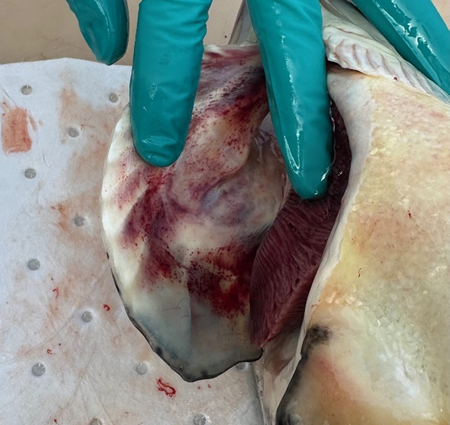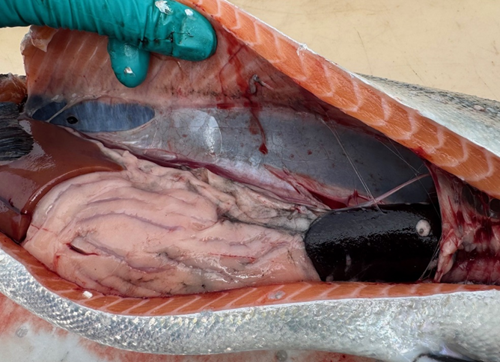
Principal scientist and immunologist Monica Gausdal Tingbø and aquaculture veterinarian Chris Matthews of PHARMAQ look at yersiniosis in salmon farming in the western Atlantic and ask: what do salmon farmers really need to know?
Why look at Yersinia ruckeri now?
(CM) Yersinia ruckeri is probably one of the best-known bacterial pathogens of salmonids- but perhaps is better known internationally as a pathogen of rainbow trout. When I began working in salmon farming 15 years ago, it was relatively uncommon to see yersiniosis at sea in Scotland. When we did, it was typically in transfers from a small handful of flow-through hatcheries where the pathogen was thought to be endemic, with relatively low-grade yersiniosis occurring shortly after transfer and tending to last a few weeks. In recent years, while the disease isn’t common in the marine stage, we have seen a gradual increase in outbreaks at sea- including in fish of over 1kg well beyond the early seawater stage. In some cases, there is no known link to infection in freshwater- suggesting a possibility that populations can be acquired the infection in the marine stage. The Norwegian Veterinary Institute’s Fish Health Report for 20241 points to a decrease in detections of yersinia ruckeri in the marine stage via PCR or culture, although the trend has been an increasing one in recent years. Respondents to their annual survey emphasise a good effect of vaccination in Norway. Anecdotally, veterinary colleagues in Norway- as in Scotland- report a general increase in outbreaks in larger salmon at sea, often following handling events in unvaccinated fish and in geographical areas where yersiniosis has not been common previously. So taken as a whole, this is a pathogen which deserves our attention in this region of the Atlantic.
Monica- the classification of Yersinia ruckeri is famously complicated. Can you explain it in simple terms?
(MGT) There are several different ways of classifying or grouping Yersinia ruckeri. The most frequently-referenced method is O-serotyping, which is based on structural differences in the O-antigen. This is part of a lipopolysaccharide (LPS) molecule, which plays a role in many different aspects of how the bacteria infects fish, including persisting in the environment, colonising the surface of the fish and evading the immune system. It’s like the bacteria’s armour!
There are multiple O-serotypes described in the academic literature- O1 through to O8 2- although confusingly O3 and O4 are the same thing as O5 and O6, respectively. However, my view is that this distinction between O-serotypes is slightly unclear, and there could in fact be fewer practically relevant O-serotypes.
Alongside O-serotyping, ‘serovar typing’ can also group yersinia ruckeri strains into at least three serovar groups (I, II and III). This is where we’re using the much broader profile of antigens of the bacterial cell surface, not just the O-antigen. While O-serotyping is based on just one antigen (the LPS O-antigen), serovar typing is based on the whole surface antigen profile. This means two strains could be O1, but belong to different serovars due to differences in LPS structures as well as motility, flagella and outer membrane proteins.
Lastly, we can classify Yersinia ruckeri by looking at it’s biotype. This is where we look at other biological traits, not necessarily the antigenic properties (unlike serotype or serovar). Biotype 1 is motile (able to move due to a functional flagella), whereas biotype 2 is non-motile. It’s hypothesised that biotype 2 emerged in trout after early widespread vaccination using whole cell vaccines may have targeted the flagellar antigen. However, recent studies on flagellar expression in a mutant biotype 2 strain compared with wild type biotype 1 strain showed no virulence advantage for the mutant biotype 2 strain as biotype 1 strains can actively regulate the flagella expression during the course of infection3.
I’ve heard about O1 being divided into O1a and O1b- what’s the difference?
(MGT) Yes- following the O-serotyping system introduced in 1993, these are two subtypes within the O1 serogroup. Though both sit within the O1 group, their O1- antigen lipopolysaccharide (LPS) is sufficiently different that we classify them differently. It’s important because vaccines against O1a may not be fully protective against O1b.
Some O1b strains may be biotype 2- but biotype isn’t decisive for vaccine protection. It’s the LPS which is decisive antigen for vaccine protection4.
Readers will also often hear about Yersinia ruckeri divided into ‘clonal complexes’- what does this mean?
(MGT) Another way of looking at Yersinia ruckeri is using genetic diversity, rather than serological reaction patterns. Studies have classified Yersinia ruckeri into clonal complexes (CC) using Multilocus variable-number tandem-repeat analysis (MLVA),5, which basically establishes how genetically related strains are by looking at specific locations in the genome where a short DNA sequence is repeated. The number of repeats varies- if they’re similar this suggests they share a common ancestor. There are 9 major clonal complexes of Yersinia ruckeri known. Strains which are antigenically similar- say O1b- could belong to different clonal complexes. Clonal complexes do not indicate O-serotype and may be of more epidemiologic value than as a vaccine efficacy indicator.
So what do Atlantic salmon farmers in particular need to know about this?
(MGT) In Norway, all outbreaks of disease in Atlantic salmon at sea have been caused by a single clonal complex (CC1)5, meaning there has been relatively little genetic diversity observed in the strain causing disease. Importantly, this strain has shown serotype O1b- which is the critical thing to know in terms of vaccination strategy.
Is the situation in Scotland similar to Norway?
(CM) Less has been published about the situation in Atlantic salmon in Scotland. One older study from 2016 found considerable serological diversity in isolates collected from Scotland, with O1, O2, O5 and O8 described.
However, what we can say from the perspective of the lab in Inverness is that in the last few years since we began seeing an increase in incidence of marine disease, all the cultures we have retrieved from these Scottish cases in the last 3 years have been O1b, with a single exception of one case with O1a.
(MGT) More than that, when we’ve performed Western Blotting (a lab technique used to detect specific antigenic structures in a sample) on Scottish field isolates previously characterised by another lab as O8, we’ve found these stain positively for O1b.
(CM) In my view, it is likely that there has indeed been quite a serologically diverse Yersinia ruckeri picture in Atlantic salmon aquaculture in the past, but the marine issues we see presently owe mostly to O1b.
What advice would you give to health teams regarding diagnostics?
(CM) Firstly, PCR is a useful tool, but doesn’t tell us much about the characteristics of the Yersinia ruckeri present. There are non-pathogenic strains of Yersinia ruckeri, so PCR detections of this pathogen should be followed up with microbiology in order to collect and characterise strains.
In general, microbiology samples are valuable because routine culture and antibiotic sensitivity screening is good practice even where an antimicrobial treatment is not being considered at that point. Having the organism in culture allows the serotype to be established, creates a record for future genetic study, and if stored may allow an autogenous vaccine to be created if a proprietary vaccine is unavailable for that serotype. Bacterial isolation may also allow screening of the suitability of bacteriophage products where they become available.
They key thing is to understand the serotype of Yersinia ruckeri present, which PHARMAQ Analytiq can arrange.
Environmental or eDNA sampling- either biofilm surface swabs or water filtrate samples, can allow us to look using PCR for Yersinia ruckeri on surfaces or post-treatment water. Prior to treatments, we have found that vent swabs from populations of fish can provide evidence of fish carrying enteric infections and which may be at risk of developing full-blown disease following a bath or treatment event. Clients can get in touch with us at PHARMAQ Analytiq to discuss options for Yersinia ruckeri surveillance.

Figure 2: A more unusual sign of seawater yersiniosis: petechial bleeding on the inner operculum. Photo: PHARMAQ Analytiq

Figure 3: Typical signs of septicaemia in an individual with yersiniosis- petechial bleeding on the swim bladder surface and enlarged spleen (splenomegaly). Fibrinous pseudomembranes are also frequently observed. Photo: PHARMAQ Analytiq
References
1 Moldal T, Wiik-Nielsen J, Oliveira VHS, Svendsen JC and Sommerset I. Norwegian Fish Health Report 2024, Norwegian Veterinary Institute Report series #1b/2025, published by the Norwegian Veterinary Institute 2025
2 Ormsby, MJ et al. (2016) Yersinia ruckeri isolates recovered from diseased Atlantic salmon (Salmo salar) in Scotland are more diverse than those from rainbow trout (Oncorhynchus mykiss) and represent distinct subpopulations. Applied and Environmental Microbiology 82, 5785-5794
3Jozwick AKS, Lapatra S, Graf J, Welch TJ (2019) Flagellar regulation mediated by the Rcs pathway is required for virulence in the fish pathogen Yersinia ruckeri. Fish and Shellfish Immunology 91 (2019) 306-314.
4Welch TJ and Lapatra S (2016) Yersinia ruckeri lipopolysaccharide is necessary and sufficient for eliciting a protective immune response in rainbow trout (Oncorhynchus mykiss, Walbaum). Fish and Shellfish Immunology 49 (206) 420-426
5Gulla S, Barnes AC, Welch TJ, Romalde JL, Ryder D, Ormsby MJ, Carson J, Lagesen K, Verner-Jeffreys DW, Davies RL, Colquhoun (2018) Multilocus Variable-Number Tandem-Repeat Analysis of Yersinia ruckeri Confirms the Existence of Host Specificity, Geographic Endemism, and Anthropogenic Dissemination of Virulent Clones. DJ.Appl Environ Microbiol. 2018 Aug 1;84(16)
PHARMAQ is the global leader in vaccines and innovation for aquaculture and part of Zoetis, the world leader in animal health. The company provides environmentally sound, safe and efficacious health products to the global aquaculture industry through targeted research and the commitment of dedicated people. Production facilities, administration and research and development activities are based in Norway with subsidiaries in Chile, United Kingdom, Vietnam, Turkey, Spain, Panama and Hong Kong. PHARMAQ has approximately 300 employees. The company's products are marketed in Europe, North and South America, and Asia. For further information, visit the company's website at www.pharmaq.com. Privacy Policy. Cookie Policy. Terms of Use.
Copyright © 2020 Zoetis LLC. All rights reserved.